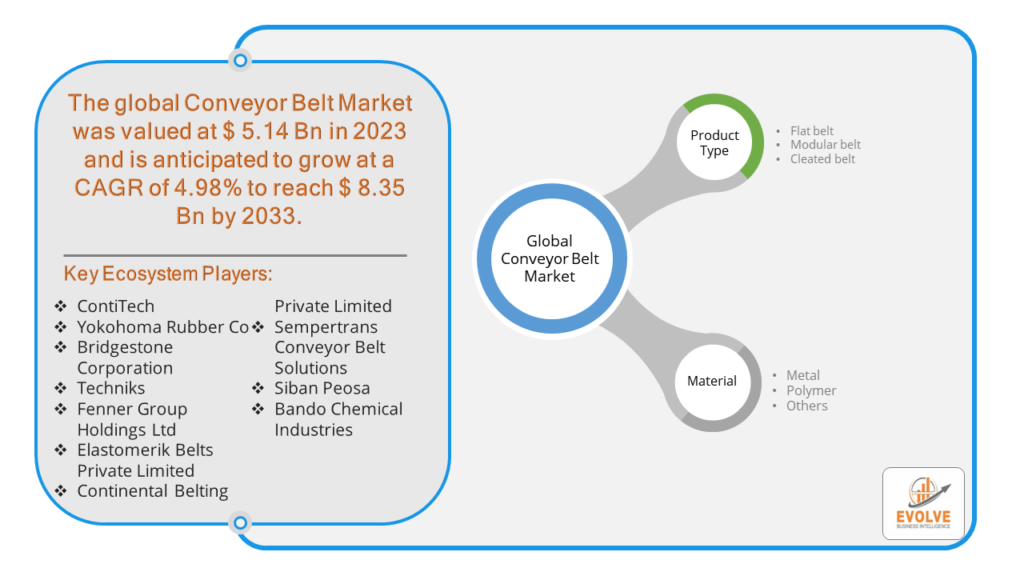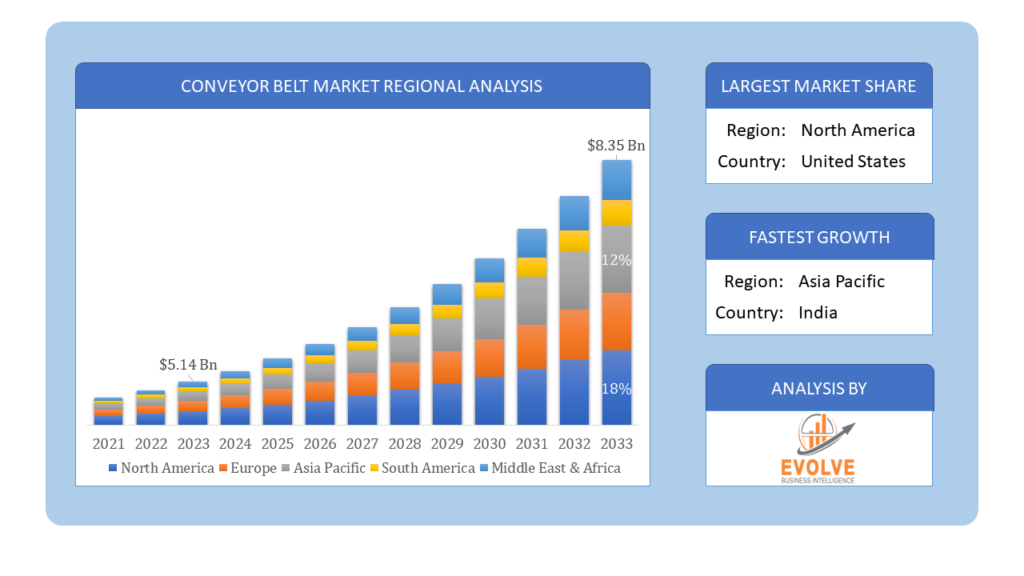Conveyor Belt Market Overview
The Conveyor Belt Market Size is expected to reach USD 8.35 Billion by 2033. The Conveyor Belt Market industry size accounted for USD 5.14 Billion in 2023 and is expected to expand at a compound annual growth rate (CAGR) of 4.98% from 2023 to 2033. The Conveyor Belt Market refers to the global industry involved in the production, sale, and distribution of conveyor belts. Conveyor belts are continuous moving strips or belts used for transporting materials from one place to another in various industries such as mining, manufacturing, food processing, and logistics.
The growth of the Conveyor Belt Market is driven by factors such as industrial automation, increased efficiency requirements, rising demand in the mining and manufacturing sectors, and advancements in conveyor belt technology.
Global Conveyor Belt Market Synopsis
The COVID-19 pandemic had a significant impact on the Conveyor Belt Market. During the peak of the pandemic, many industries such as manufacturing, mining, and food processing either shut down or operated at reduced capacity. This led to a decreased demand for conveyor belts used in these industries. Manufacturing facilities faced challenges in maintaining operations due to social distancing measures, workforce shortages, and interruptions in the supply of raw materials, leading to production delays. Restrictions on transportation and logistics services hampered the distribution of conveyor belts, affecting market dynamics and causing delays in project completions. The pandemic accelerated the adoption of automation and digitalization in various industries. Conveyor belts, being integral to automated systems, saw a boost in demand as companies invested in automated material handling solutions to reduce dependency on human labor and improve efficiency. The pandemic highlighted the need for more resilient supply chains. Companies are now focusing on diversifying their supplier base and increasing local production capabilities to mitigate future disruptions.
Conveyor Belt Market Dynamics
The major factors that have impacted the growth of Conveyor Belt Market are as follows:
Drivers:
Ø Technological Advancements
Innovations in conveyor belt technology, such as the development of smart belts with integrated sensors for monitoring and maintenance, are driving market growth. These advancements improve efficiency, reduce downtime, and enhance overall productivity. The growth of the manufacturing and mining industries boosts the demand for conveyor belts. These sectors rely heavily on conveyor systems for transporting raw materials and finished products. The rapid expansion of the e-commerce sector and the corresponding increase in logistics activities require advanced material handling systems in warehouses and distribution centers, driving demand for conveyor belts. The global demand for minerals and resources is rising, leading to increased mining activities. Conveyor belts play a critical role in transporting extracted materials, boosting the demand in the mining sector.
Restraint:
- Perception of High Initial Investment
The cost of installing and setting up conveyor belt systems can be substantial, especially for small and medium-sized enterprises (SMEs). This high initial investment can deter some businesses from adopting conveyor belt solutions. While conveyor belts improve efficiency, they also require regular maintenance and operational oversight. The costs associated with upkeep, repairs, and potential downtime can be significant, impacting the overall cost-effectiveness for some users. The prices of raw materials used in manufacturing conveyor belts, such as rubber, PVC, and metals, can be volatile. Fluctuations in these prices can affect production costs and profit margins for manufacturers, leading to potential price increases for end-users.
Opportunity:
⮚ Environmental Sustainability
The growing emphasis on sustainability and environmental responsibility creates opportunities for conveyor belt manufacturers to develop eco-friendly and recyclable materials. Green technologies and sustainable practices can enhance market competitiveness. The global demand for minerals and resources continues to grow, boosting the demand for conveyor belts in the mining industry. Conveyor belts are critical for transporting materials in mining operations, presenting opportunities for manufacturers to supply robust and reliable solutions. There is increasing demand for customizable conveyor belt solutions that can handle diverse materials and operational requirements. Manufacturers can capitalize on this demand by offering flexible and versatile conveyor belt systems.
Conveyor Belt Market Segment Overview
By Product Type
 Based on Product Type, the market is segmented based on Flat belt, Modular belt and Cleated belt. The Flat belt segment dominant the market. Flat belts are the best viable option for many industrial applications. They are used to transport lighter products such as consumer goods and food item as well as medium-heavy materials in mining, quarrying, cement making, stone crushing etc.
Based on Product Type, the market is segmented based on Flat belt, Modular belt and Cleated belt. The Flat belt segment dominant the market. Flat belts are the best viable option for many industrial applications. They are used to transport lighter products such as consumer goods and food item as well as medium-heavy materials in mining, quarrying, cement making, stone crushing etc.
By Material
Based on Material, the market segment has been divided into the Metal, Polymer and Others. The Metal segment dominant the market. The Metal segment dominant the market. It’s driven by the demand for robust and hygienic material handling solutions across various industries. As industries continue to automate and upgrade their processes, the demand for durable and efficient metal conveyor belts is likely to increase. Innovations in materials and manufacturing processes are expected to further enhance the performance and reliability of metal conveyor belts.
Global Conveyor Belt Market Regional Analysis
Based on region, the global Conveyor Belt Market has been divided into North America, Europe, Asia-Pacific, the Middle East & Africa, and Latin America. North America is projected to dominate the use of the Conveyor Belt Market followed by the Asia-Pacific and Europe regions.
 Conveyor Belt North America Market
Conveyor Belt North America Market
North America holds a dominant position in the Conveyor Belt Market. United States and Canada countries have a well-established industrial base and significant investments in automation and manufacturing sectors. The demand for conveyor belts is driven by industries such as automotive, food processing, and logistics.
Conveyor Belt Asia-Pacific Market
The Asia-Pacific region has indeed emerged as the fastest-growing market for the Conveyor Belt Market industry. Asia-Pacific is a major market for conveyor belts due to rapid industrialization, urbanization, and infrastructure development. China and India, in particular, have a robust manufacturing sector that drives demand for conveyor belts. Rapid industrialization and the expansion of e-commerce drive significant demand for conveyor belts. Manufacturers in this region are also investing in technological advancements and sustainability.
Competitive Landscape
The global Conveyor Belt Market is highly competitive, with numerous players offering a wide range of software solutions. The competitive landscape is characterized by the presence of established companies, as well as emerging startups and niche players. To increase their market position and attract a wide consumer base, the businesses are employing various strategies, such as product launches, and strategic alliances.
Prominent Players:
- ContiTech
- Yokohoma Rubber Co
- Bridgestone Corporation
- Techniks
- Fenner Group Holdings Ltd
- Elastomerik Belts Private Limited
- Continental Belting Private Limited
- Sempertrans Conveyor Belt Solutions
- Siban Peosa
- Bando Chemical Industries
Scope of the Report
Global Conveyor Belt Market, by Product Type
- Flat belt
- Modular belt
- Cleated belt
Global Conveyor Belt Market, by Material
- Metal
- Polymer
- Others
Global Conveyor Belt Market, by Region
- North America
- US
- Canada
- Mexico
- Europe
- UK
- Germany
- France
- Italy
- Spain
- Benelux
- Nordic
- Rest of Europe
- Asia Pacific
- China
- Japan
- South Korea
- Indonesia
- Austalia
- Malaysia
- India
- Rest of Asia Pacific
- South America
- Brazil
- Argentina
- Rest of South America
- Middle East & Africa
- Saudi Arabia
- UAE
- Egypt
- South Africa
- Rest of Middle East & Africa
| Parameters | Indicators |
|---|---|
| Market Size | 2033: $8.35 Billion/strong> |
| CAGR | 4.98% CAGR (2023-2033) |
| Base year | 2022 |
| Forecast Period | 2023-2033 |
| Historical Data | 2021 |
| Report Coverage | Revenue Forecast, Competitive Landscape, Growth Factors, and Trends |
| Key Segmentations | Product Type, Material |
| Geographies Covered | North America, Europe, Asia-Pacific, Latin America, Middle East, Africa |
| Key Vendors | ContiTech, Yokohoma Rubber Co, Bridgestone Corporation, Techniks, Fenner Group Holdings Ltd, Elastomerik Belts Private Limited, Continental Belting Private Limited, Sempertrans Conveyor Belt Solutions, Siban Peosa and Bando Chemical Industries |
| Key Market Opportunities | • Environmental Sustainability |
| Key Market Drivers | • Technological Advancements • E-commerce and Logistics Growth |
REPORT CONTENT BRIEF:
- High-level analysis of the current and future Conveyor Belt Market trends and opportunities
- Detailed analysis of current market drivers, restraining factors, and opportunities in the future
- Conveyor Belt Market historical market size for the year 2021, and forecast from 2023 to 2033
- Conveyor Belt Market share analysis at each product level
- Competitor analysis with detailed insight into its product segment, Government & Defense strength, and strategies adopted.
- Identifies key strategies adopted including product launches and developments, mergers and acquisitions, joint ventures, collaborations, and partnerships as well as funding taken and investment done, among others.
- To identify and understand the various factors involved in the global Conveyor Belt Market affected by the pandemic
- To provide a detailed insight into the major companies operating in the market. The profiling will include the Government & Defense health of the company’s past 2-3 years with segmental and regional revenue breakup, product offering, recent developments, SWOT analysis, and key strategies.






